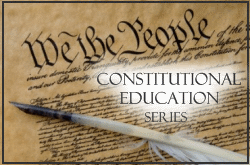 It’s important that we educate our children on the topics of politics, government, and the Constitution which governs our nation. This nine-part series attempts to remind us of some basic principles, lest they be forgotten by the next generation.
It’s important that we educate our children on the topics of politics, government, and the Constitution which governs our nation. This nine-part series attempts to remind us of some basic principles, lest they be forgotten by the next generation.In this series, we have presented various viewpoints about how the government derives its power and abilities. The truth is that there is much debate over the extent of what the federal government should be involved in. Our nation continues to give up increasing power and authority to the federal government – at the expense of states’ right and individual liberties (see Part 2 and Part 5).
We’ve also seen how the founding fathers had some disagreement over the extent of defined federal powers in the Constitution (Part 6). On the conservative side of the issue, both Thomas Jefferson and James Madison opposed the expenditure of federal tax dollars for road-building projects – simply because they could find no authority to explicitly do so in the Constitution. They chose to leave this to the states and to private enterprise.
So where did the idea start that the federal government could get a foothold into almost anything? It all began with four little words in the Preamble of the Constitution – in the very first sentence:
“We the People of the United States, in Order to form a more perfect Union, establish Justice, insure domestic Tranquility, provide for the common defence, promote the general Welfare, and secure the Blessings of Liberty to ourselves and our Posterity, do ordain and establish this Constitution for the United States of America.”“Promote the general Welfare” – these are words that Thomas Jefferson almost certainly wished that he had left out when writing the document. It is these words upon which most of our governmental leaders base their ability to spend tax money. Read the above preamble once again – but leave out these four words – and you will see an entirely different and far more limited view of government than we have today.
The general welfare clause appears again in the Constitution in Article 1, Section 8, which lists the powers given to the Congress. And the Congress has used (and sometimes abused) this clause to the fullest – they build roads, fund overseas abortion clinics, impose exhorbitant income taxes, and even tax death through inheritance tax laws. Alexander Hamilton, one of the very first proponents of a liberal definition of “general welfare” said, “[T]he power to raise money is plenary and indefinite [in the Constitution]. The terms general welfare were doubtless intended to signify more than was expressed.” Trillions of tax dollars would agree with him.
The sad fact is that promotion of “general welfare” is such an ill-defined and nebulous phrase that there will be no end to the debate over its meaning. Indeed, instead of debating the legality of whether the federal government should fund medical research for cancer, nearly all of our lawmakers will just argue about the amount to spend or which lab in their state will get the money. It seems a foregone conclusion among members of Congress that they have the right to spend our money wherever they wish. And they have taken it even farther – by spending our children’s and grandchildren’s money today, through deficit spending. Any government deficit today must be paid by taxes tomorrow. The amount of debt that our leaders are incurring today necessitates the taxing of money that our offspring have not yet earned. And when you look at it that way, does that really fit with the Constitutional preamble, when it says we should “secure the blessings of Liberty to…our Posterity”? Our posterity is the future generations of Americans that will follow us. Shouldn’t their welfare be taken into account, as well?
Next article: What brought about the birth of “judicial activism”? Was this interpretation intended by the founding fathers? Back to the main index article.

















